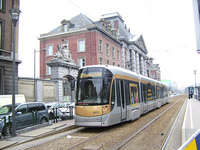Bombardier announces contactless light rail power system

Bombardier FLEXITY tram, the vehicles PRIMOVE would use, in Brussels. Photo by vitalyzator on Flickr.
Bombardier, a major manufacturer of transit vehicles and systems, just announced and demonstrated a new power system for light rail vehicles, called PRIMOVE, that doesn’t use overhead wires. The power system transfers energy by electromagnetic induction, making direct electrical connections unnecessary.
Electromagnetic induction works by using a varying electric current (or magnetic field) to induce a current in a nearby loop of wire. The technology is used in electric power transformers, those “shake to charge” flashlights, and most electric motors. You can read about it or experiment yourself with a loop of wire, a small light and a bar magnet. By moving the magnet within or near the loop connected to the light, you can induce electric power which lights the bulb. There’s a pretty cool virtual demonstrator here. The Wikipedia page has a lot of impressive-looking math on it, but basically, it allows for electric energy transfer without physical contact between the wires. That’s important because it allows the track-side electrical equipment to be covered and out of the weather, and also completely insulated so it doesn’t pose a hazard to pedestrians or cyclists. In PRIMOVE, the power-sending coil is embedded under the road surface, and a receiving coil in the train collects power.
The new power system might be an option for downtown DC. Most streetcar systems use thin, relatively unobtrusive overhead wires, but at least according to NCPC, federal law prohibits overhead wires in the original L’Enfant portion of DC.
The system has some drawbacks, some fairly significant:
- The system is designed and manufactured by a sole-source vendor, potentially locking the transit agency into purchasing more expensive technology without competitive bidding. This is also a problem with the Alstom INNORAIL (PDF) in-ground power systems used in Bordeaux, France, the other major alternative to overhead wires.
- In the future, upgrades to the track power system (to accommodate more vehicles, heavier vehicles, or even vehicles of a different brand) would be more expensive and disruptive because the power systems are installed underground.
- Since the technology is newer, more complicated, and not extensively tested (unlike overhead wires), the tracks will likely cost more to purchase, construct, and maintain.
- Since it’s a new technology, it’s possible that there could be unanticipated problems with reliability or performance compared with traditional overhead wire service. Bordeaux had many frustrating problems with INNORAIL, for example.
- DC has already purchased some light rail vehicles that are currently sitting unused (actually, driving around without passengers to stay in working order) in the Czech Republic. We’d have to replace those vehicles to use the system.
The presentation/fact sheet (PDF) claims that this system doesn’t hurt vehicle performance. The hazards to cyclists and pedestrians were what prevented me from supporting the INNORAIL system, the previous state-of-the-art wireless alternative. Because that system uses actual electical connections as opposed to induction, it’s susceptible to damage or malfunction from contact with snow or rain. Malfunctions in the circuit can create dangerous energized electrical plates at street level.
From the Bombardier promotional video, it appears the same vehicle can receive power through an overhead wire, or retracting a pantograph and running on the PRIMOVE system. That would allow DC to use a hybrid system, as they did decades ago. Inside the L’Enfant City, underground electrical conduits provided power, but outside the boundary, the vehicles switched to overhead wires.
DDOT can now consider this system when designing and installing DC’s streetcar system. It’s currently planning a line in Anacostia, and laying the groundwork (literally) for one on Benning Road/H Street by installing tracks, but no power systems or actual service, on H and Benning during the upcoming streetscape renovation. This way, they can avoid ripping up the street again to build a streetcar line. As Richard Layman points out, though, if DC ends up using this system, they’ll have to redo those tracks anyway to add the in-ground power systems.
Via Yonah Freemark at The Transport Politic and MSNBC.
Update: I forgot to mention the vehicles DC already purchased among the drawbacks. Thanks to Richard Layman.
